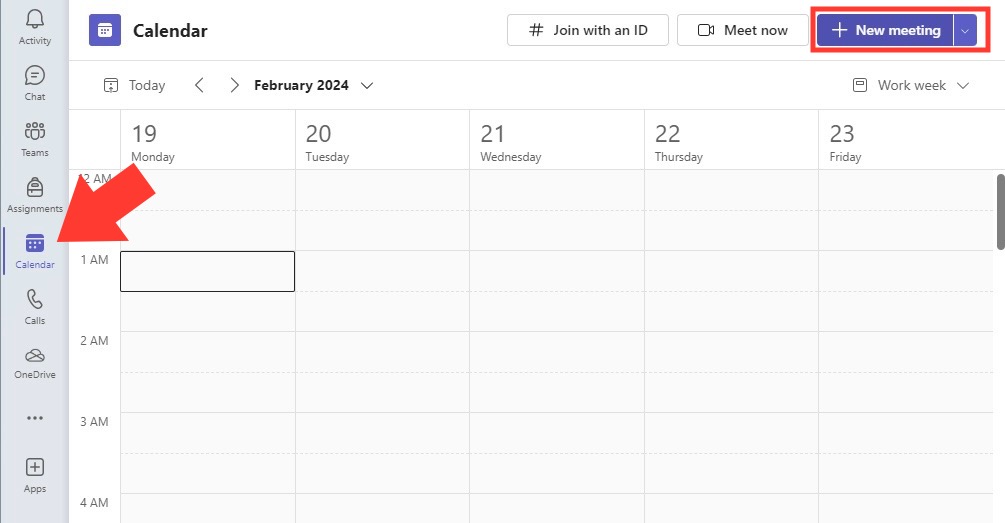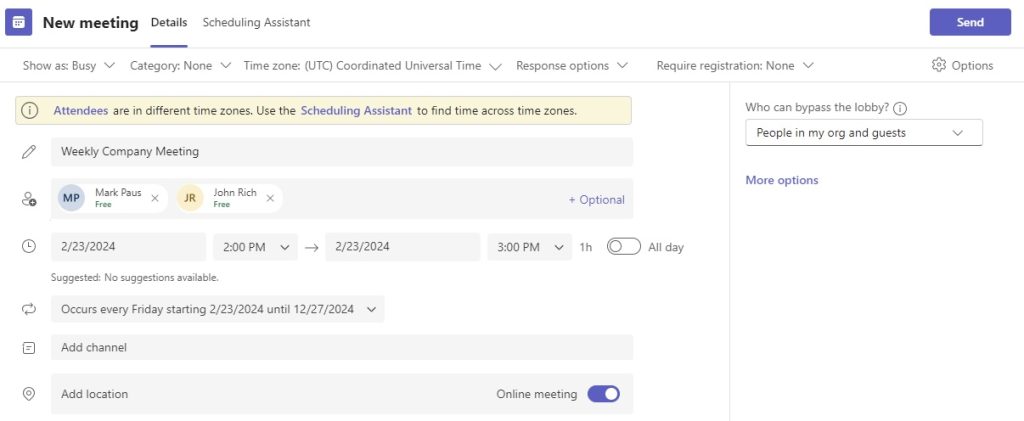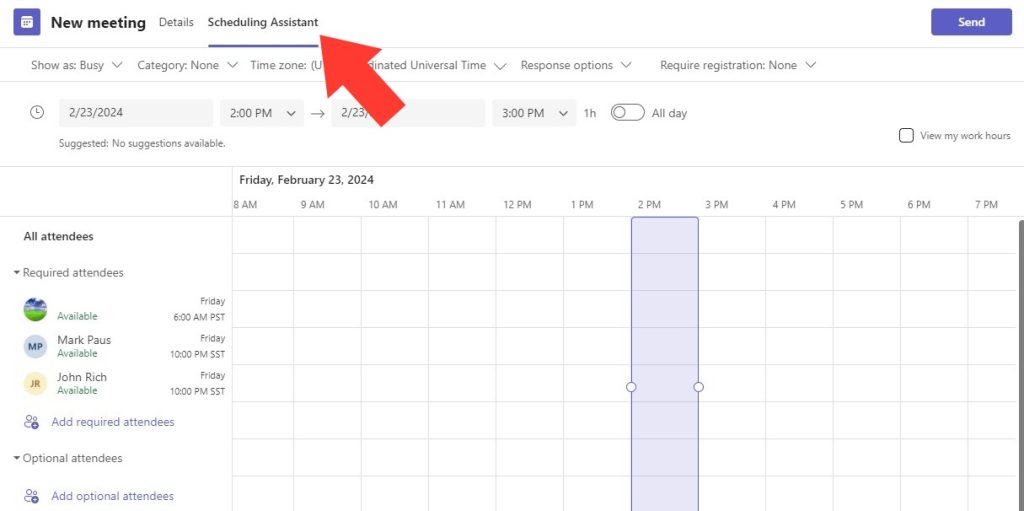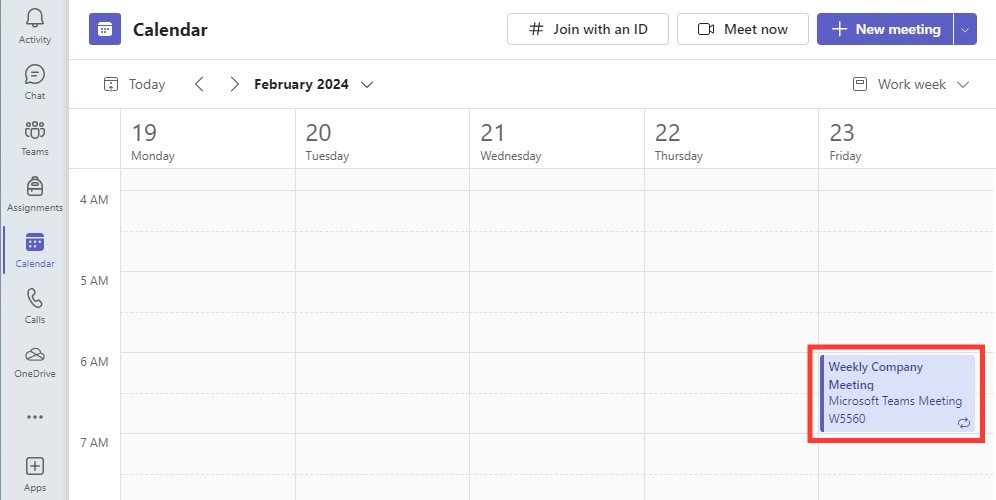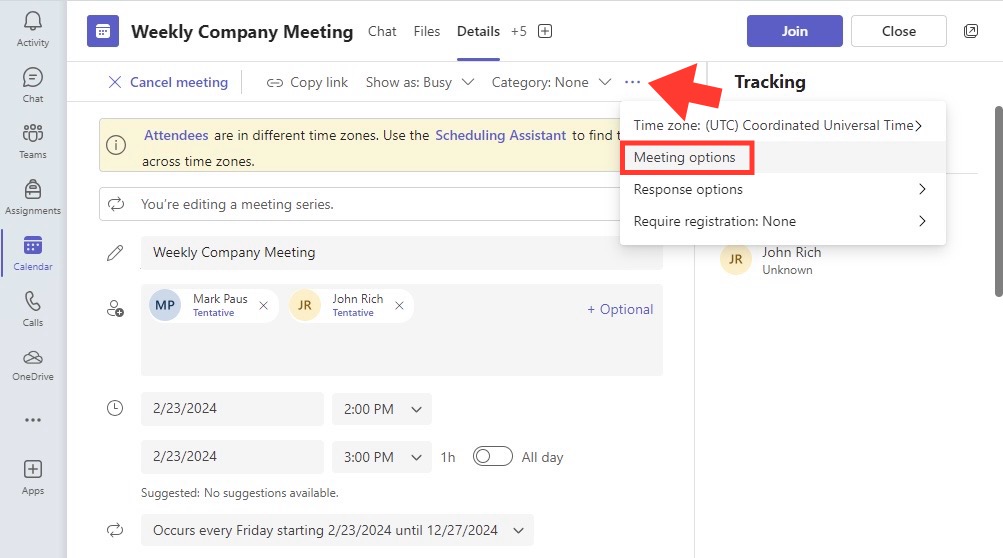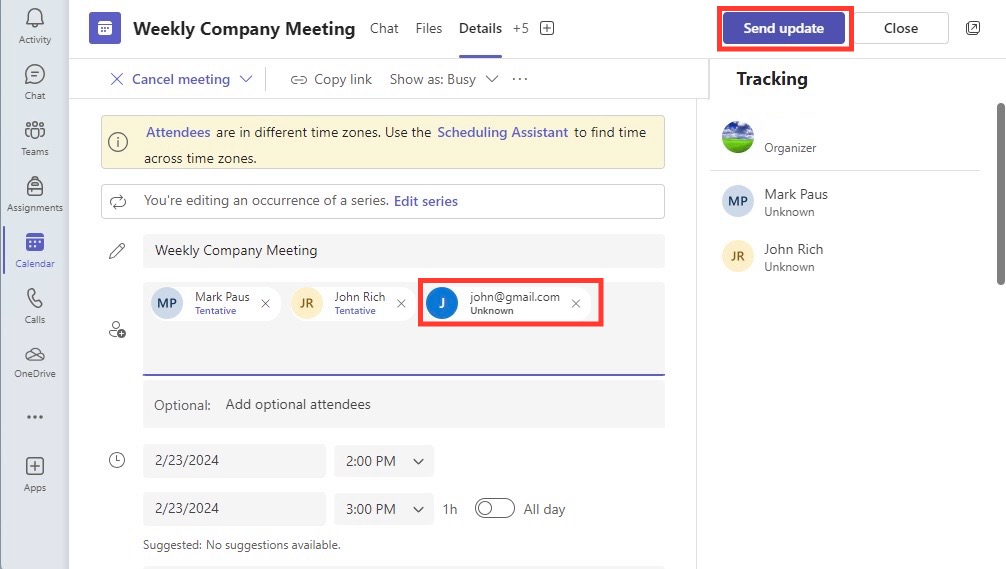Learn about Excel with our Free Microsoft Excel Online Course.
Key Takeaways
- To create a Microsoft Teams meeting link for guests, first sign in to the Microsoft Teams application, navigate to the “Meetings” tab in the left navigation panel, and then click on the “New Meeting” button to start the setup process.
- After setting up the meeting details such as the title, date, and time, select the “Create a meeting link” option to generate a unique link, which can then be copied and sent to guests, allowing them to join the meeting without requiring a Microsoft account.
- Ensure the meeting is accessible to guests by adjusting the meeting options if necessary, and then distribute the link via email or any other preferred communication channel to offer your guests a seamless access experience to the Microsoft Teams meeting.
Overview of Creating a Teams Link for Guests
Creating a Microsoft Teams meeting link for guests encompasses more than just setting up a virtual meeting room; it represents a bridge that connects various stakeholders from different settings to a centralized digital collaboration space. This process is facilitated by Microsoft Teams through intuitive controls that allow meeting organizers to specify meeting details like date, time, and recurrence, and to extend invitations in a manner that is both inclusive and secure.
Even individuals without a Teams account can participate in meetings, ensuring participation is not limited to your organization’s walls. The resultant link is a unique URL that, when accessed, transports guests into the designated meeting, providing them with a seamless virtual join experience.
Table of Contents
Step-by-Step Guide to Generating a Teams Meeting Link
Schedule Your Teams Meeting with Ease
Scheduling a Teams meeting, including for guests, should be a smooth and straightforward process. Here’s how you can get it done:
STEP 1: Navigate to your Teams application and select ‘Calendar’ on the left-hand sidebar.
STEP 2: Click on ‘New Meeting’ at the top-right corner of your screen.
STEP 3: A scheduling form will appear. Here, input the meeting title, date, and time.
STEP 4: In the invite attendees section, add the email addresses of both internal team members and external guests.
STEP 5: Use the ‘Scheduling Assistant’ to find a time slot that serves all participants well. This tool is particularly handy as it shows you when invitees are busy or available, simplifying the process of finding a suitable time for everyone.
Once these steps are followed, the Teams link will be generated and included automatically in the meeting invitation that can be sent out to both internal and external participants. This means guests will have easy click-to-join access to your meeting when it’s time.
Remember to set the meeting options to allow for external participants if your organization’s default settings do not automatically enable guest access.
Customizing Meeting Options for Guest Security
To ensure guest security and maintain control over your Microsoft Teams meeting, you must customize your meeting options effectively. Here are the steps to customize meeting settings for enhanced guest security:
STEP 1: After scheduling your meeting, navigate back to your Teams calendar and click on the meeting you’ve just created.
STEP 2: Inside the meeting details page, find the “Meeting options” hyperlink.
STEP 3: Click the link to be redirected to a page where you can adjust key parameters for your meeting.
Here’s what you can do within the meeting options to secure your meeting:
- Who can bypass the lobby? By default, you might want to allow everyone to bypass the lobby, but for secure meetings, you should consider setting it so that only people in your organization and trusted organizations bypass the lobby, while guests wait to be admitted.
- Who can present? This option can be set to ‘Everyone’, ‘People in my organization’, specific people, or only me. Limiting who can present can prevent unauthorized control of the meeting.
- Require Authentication to Join: Enable “Require Authentication to Join” by selecting people in your organization, people in your organization and trusted organizations, or specific people.
- Require Attendees to be Signed In: You can require all participants to sign in with their Microsoft account to join the meeting. This adds an extra layer of security as you can track user identities.
- Allow Mic and Camera: Determine who should have immediate access to their microphone and camera upon joining the meeting.
To implement guest access controls:
- Make Private Calls: Turn this on if you want to allow guests to make peer-to-peer calls.
- Video Conferencing: Enable this to allow guests to participate in video conferencing.
Customizing these settings shapes a safer and more managed meeting environment, ensuring that sensitive information remains protected while fostering fruitful external collaboration.
Streamlining Guest Participation
Inviting Guests Correctly: A Crucial Step
Inviting guests correctly is integral to ensuring that your meeting goes smoothly. Proper invitations provide guests with all necessary information and ensure their seamless entry into your Teams meeting. Here’s the process:
STEP 1: Select ‘Send’ in the upper-right corner of the meeting window.
STEP 2: Invited presenters and attendees will receive an email with the meeting details, including the Teams meeting link.
STEP 3: The registration link will become active, allowing guests to register if that’s a part of your meeting setup.
STEP 4: Within the Teams platform, go to the meeting details and click ‘Edit’.
STEP 5: Enter the email addresses of other invited guests in the designated field.
STEP 6: Once you click ‘Send update’, the newly added guests will receive their invitations.
By ensuring that the invitation process is handled correctly, you can attain higher attendance rates, smoother meeting initiation, and an overall more productive Teams meeting experience for all participants.
Managing Guest Permissions for a Smooth Experience
For a smooth experience during a Microsoft Teams meeting, managing guest permissions is essential. These permissions control what actions guests can perform within the meeting environment, such as sharing content or using certain communication features. To manage these settings effectively:
- Calling: Decide if you want guests to be allowed to make private calls.
- Meet now in channels: Allow guests to start immediate, ad-hoc meetings with the ‘Meet Now’ feature.
- Chat: Enable chat functionality for guests so they can communicate during meetings.
- Screen sharing: Control how guests share content during meetings by selecting ‘Not enabled’, ‘Single application’, or ‘Entire screen’.
- Video conferencing: Allow guests to participate with video to foster a more interactive session.
- Messaging: Choose whether guests can edit and delete sent messages and entire chat conversations.
- Giphys, Memes, and Stickers in conversations: Determine whether these features are enabled and select a content rating to filter out inappropriate content.
By managing these permission settings, you ensure that guests can contribute effectively while also retaining control over the meeting environment. Properly set permissions not only empower your guests to participate fully but also safeguard the integrity of your meeting, preventing any unauthorized actions that might disrupt the meeting flow.
Balancing open collaboration with security is key; provide enough access so that guests feel like active participants within the meeting while also safeguarding your organization’s and participants’ privacy.
Troubleshooting Common Teams Link Issues
Addressing Problems When Guests Can’t Join
When guests encounter issues joining a Microsoft Teams meeting, it’s important to pinpoint and address the source of the problem quickly. Here’s how to troubleshoot common issues:
- Ensure the meeting link is correct: Verify that there are no typos or incorrect formatting in the meeting link. If uncertain, generate a new link and share it again with the attendees.
- Check for network outages: Confirm that there are no ongoing network issues that could be preventing guests from joining.
- Review guest permissions: In your Teams admin center, validate that guest access is enabled and that the necessary permissions are assigned that allow guests to join the meeting.
- Browser compatibility: Advise guests who are using Microsoft Teams to attempt joining the meeting through the Microsoft Edge browser, as it tends to work most seamlessly with Teams.
- Account conflicts: If the guest is logged into another organization’s Teams account, it may conflict with joining your Teams meeting. They should log out of their own company’s Teams account or join as a guest in an incognito browser window.
- Update Microsoft Office: Check if guests are on an older version of Windows or Microsoft Office that might not be compatible with newer Teams features. Updating the software or joining via a web browser may resolve the issue.
- Check email filters and spam folders: Sometimes, meeting invites may end up in the spam or junk folder of the guest’s email. Make sure they check these folders if they can’t find the meeting invitation.
- Direct Join Instructions: Provide clear instructions on how guests can join the meeting directly from the invite, especially for those who are not familiar with Microsoft Teams.
By following these steps, most issues that prevent guests from joining a Microsoft Teams meeting can be resolved promptly, such that all participants can contribute effectively to the meeting’s agenda.
Ensuring High-Quality Audio and Video for All Participants
Ensuring that all participants have access to high-quality audio and video is vital for the success of a Microsoft Teams meeting. Here are steps to troubleshoot and enhance the multimedia experience:
1. Network Bandwidth: Advise participants to check their internet connection. A stable and robust network is fundamental for good audio and video quality. If the connection is weak or unstable, suggest connecting to a wired network if possible, or moving closer to the Wi-Fi router.
2. Close Unnecessary Programs: Running multiple applications can consume significant bandwidth and system resources. Encourage participants to close any non-essential programs to free up bandwidth for the Teams meeting.
3. System Updates: Check for and install any pending system or application updates. Sometimes, out-of-date software can lead to performance issues.
4. Router Reset: A simple reset of the router can sometimes resolve network sluggishness and improve connection quality.
5. Browser Cache and Cookies: If participants are joining through a web browser, clearing the cache and cookies might solve certain issues, such as slow interface responses or trouble accessing meeting controls.
6. Browser Choice: Some browsers perform better with Microsoft Teams. If participants are experiencing issues, they might want to switch to Microsoft Edge or Google Chrome, which are often most compatible with Teams.
7. Extension Interference: Browser extensions can sometimes interfere with web applications. Try disabling extensions to see if this improves meeting performance.
8. Device Audio and Video Settings: Guests should check their device settings to ensure their microphone and camera are selected and functioning. They can do this before joining the meeting by clicking on ‘Device settings’ from the pre-join screen.
9. Joining via Room Systems: For guests wanting to join a meeting using meeting room equipment, they can utilize the Teams feature to connect to a meeting room by enabling Bluetooth on their device to detect rooms nearby and selecting ‘Room audio’.
By preemptively addressing these common audio and video quality issues, you can significantly reduce the likelihood of disruptions during your Microsoft Teams meetings and ensure a professional and productive experience for all participants.
Enhancing Guest Experience in Microsoft Teams
Tips for an Engaging and Inclusive Meeting
Creating an engaging and inclusive Microsoft Teams meeting can foster a collaborative atmosphere and ensure that all participants feel valued and heard. Here are some tips to achieve this:
- Send Pre-Meeting Materials: Distribute any relevant agenda, data, or documents beforehand to allow participants to prepare and contribute meaningfully.
- Use Icebreakers: If the meeting involves new team members or guests, start with a brief icebreaker to create a welcoming environment.
- Interactive Features: Employ the use of interactive features such as live polls, Q&A sessions, or breakout rooms to stimulate engagement and interaction.
- Clear Roles and Responsibilities: Assign clear roles, such as note-takers or moderators, to structure participation and ensure meetings remain on topic.
- Inclusive Language and Practices: Make sure to use language that includes all participants and be mindful of different time zones when scheduling meetings.
- Regular Breaks: For longer meetings, schedule short breaks to maintain attendees’ concentration and comfort.
- Provide Different Participation Options: Recognize that people have different communication preferences by providing various ways to contribute, such as via chat or using the “hands up” feature.
- Encourage Video Use: Encourage participants to use their video to foster a more personable and connected experience, but also respect those who prefer to keep it off.
- Accessibility Features: Teams offers live captioning, screen reader support, and adjustable display settings, which should be encouraged to aid participants with different needs.
By following these guiding principles and leveraging the tools that Microsoft Teams provides, you can host meetings that are not only effective and productive but also ensure a positive experience for everyone involved.
Advanced Features to Improve Collaboration with Guests
Microsoft Teams offers a suite of advanced features designed to improve collaboration with guests. Leveraging these features can enhance the meeting experience for everyone involved. Here are some of the advanced features that you can utilize:
- Screen Sharing and Whiteboard: Use the screen sharing functionality for presentations or to collaboratively work on documents. The Whiteboard feature also allows for real-time brainstorming and problem-solving with guests.
- File Collaboration: Guests can collaborate on files stored in Teams or SharePoint during meetings, with changes being saved automatically and synced for all users with access to the document.
- Recording Meetings: Record your Teams meetings to make them available for review later or for those who couldn’t attend in real-time. Ensure all participants are aware that the meeting is being recorded for privacy and compliance.
- Live Captions and Transcription: Improve accessibility by turning on live captions during the meeting. Additionally, utilize the transcribing feature to provide a written record of everything that was discussed, which can be shared with attendees afterward.
- Breakout Rooms: Divide the meeting into smaller groups with Breakout Rooms to facilitate more focused discussions or activities. This feature is especially useful during workshops or training sessions with guests.
- Background Effects: Encourage guests to use background effects or custom backgrounds to maintain professionalism and privacy if needed.
- Meeting Insights: Utilize the Insights feature, which uses AI to help users find information before, during, and after meetings, such as relevant files and conversation threads.
- Shared Channel in Teams: With shared channels, you can collaborate with people outside your organization more closely in the flow of your work. This allows both internal and external members to chat, have meetings, collaborate on apps, and share files — all in one channel.
By integrating these advanced features into your collaborative efforts on Microsoft Teams, you can offer a more robust and engaging meeting experience that maximizes productivity and fosters a closer working relationship with your guests.
FAQ
How Can I Enable Guest Access in My Teams Meeting?
Enabling guest access in Microsoft Teams meetings allows individuals who are not part of your organization to join your meetings. Here’s the step-by-step process to enable guest access:
- Making private calls
- Participating in video conferencing
- Sharing their screen
- Using the ‘Meet now’ feature
- Editing and deleting sent messages
- Using chat within Teams
- Employing media like Giphys, Memes, and Stickers in conversations
It’s important to remember that changes to guest access permissions might take a few hours to propagate across your Teams environment. Once guest access is set up, you can add guests to teams and meetings by typing their email addresses into the invite section when you schedule a meeting or add members to a team.
By enabling and managing guest access, you can effectively include external partners, clients, and other stakeholders in your Microsoft Teams collaboration efforts.
Are There Limitations for Guests Using a Microsoft Teams Meeting Link?
Guests using a Microsoft Teams meeting link do encounter certain limitations which are important to be aware of:
- Microsoft Teams allows guest access as part of the Microsoft 365 Business Basic or Microsoft 365 Business Standard plans. If you are using a free plan or another plan that doesn’t support guest access, guests will be unable to join meetings.
- For free plans, Microsoft Teams meetings can accommodate up to 300 participants, which includes both registered users and guests.
- Guests may not have access to all the features that are available to full members of the team. For example, they may be restricted in their ability to browse the team or group calendar, depending on the settings enforced by the administrator.
- Despite having certain access within a meeting, guests are not granted full administrative rights, such as the ability to manage the meeting recording or change meeting options after the link has been shared.
- While guests are not required to install the Microsoft Teams application and can join meetings via a web browser, the browser experience might offer limited functionalities compared to the desktop or mobile app. For instance, some browsers may not support all video features.
- Hosts can control guest permissions within a meeting, including restrictions on presenting and sharing content. This can limit a guest’s ability to share their screen or take control of a presentation unless the host has granted them those capabilities in the meeting options.
Guests using a Microsoft Teams Meeting Link should ensure they understand these limitations and check with their host if they require specific features or permissions to participate fully in a meeting. Hosts should clearly communicate any such limitations to their guests beforehand to ensure a smooth meeting experience.
How do you invite someone to a team meeting as a guest?
Inviting someone to a Microsoft Teams meeting as a guest is a relatively simple process. Here’s what you need to do to include guests in your next Teams meeting:
For Scheduled Meetings:
- Open your Microsoft Teams app and navigate to the Calendar tab on the left-hand side.
- Click on New Meeting at the top right corner of the app.
- Fill out the meeting details, including the title, date, and time.
- In the Invite people box, type in the email address of the external guest you’d like to invite.
- Once you’ve included all necessary attendees, click Save or Send to distribute the invites.
For Instant Meetings:
- Type the name or email address of the person within your organization and select them from the suggestions.
- If you want to invite someone not in your organization, select the Copy join info option and send the meeting details to them by pasting this information into an email or any other messaging service.
Guests will receive an email with the meeting invite, which includes a link to join the Teams meeting. When they click on this link, they will be directed to either open the Microsoft Teams application if they have it installed or they’ll have the option to join the meeting via a web browser. If they do not have a Teams account, they can join the meeting as a guest without needing to sign up for Teams.
As a host, ensure that you have enabled guest access in your Teams admin settings, and check the meeting options if you need to adjust permissions for guests, such as who can bypass the lobby or who can present during the meeting.
By following these steps, you should be able to invite anyone as a guest to your Microsoft Teams meeting, whether they’re a part of your organization or not.
John Michaloudis is a former accountant and finance analyst at General Electric, a Microsoft MVP since 2020, an Amazon #1 bestselling author of 4 Microsoft Excel books and teacher of Microsoft Excel & Office over at his flagship MyExcelOnline Academy Online Course.

